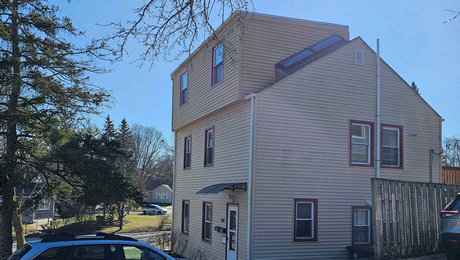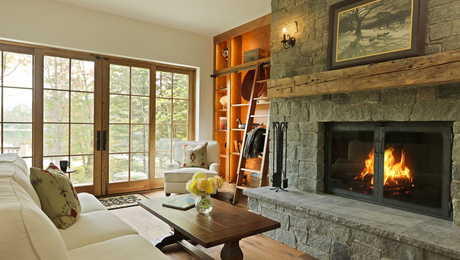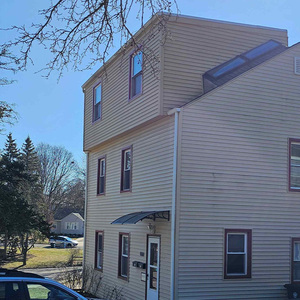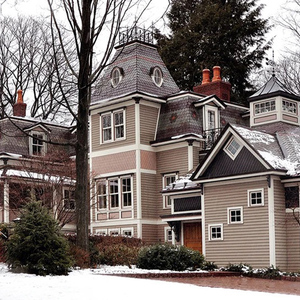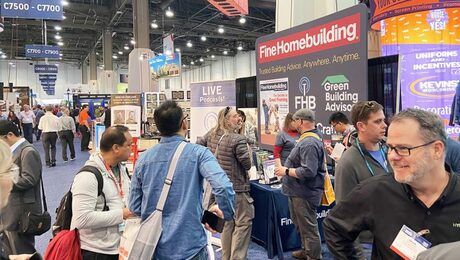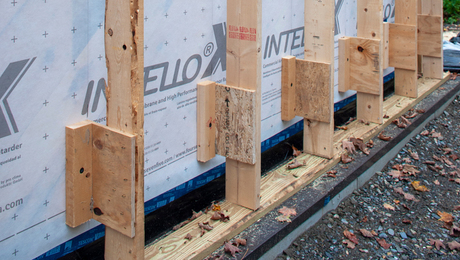Podcast Episode 669: Seeing Heat loss, Detailing Behind Masonry, and Insulating a Cathedral Ceiling
Listeners write in about a fondness for palm nailers, German translations, and insulating behind masonry.
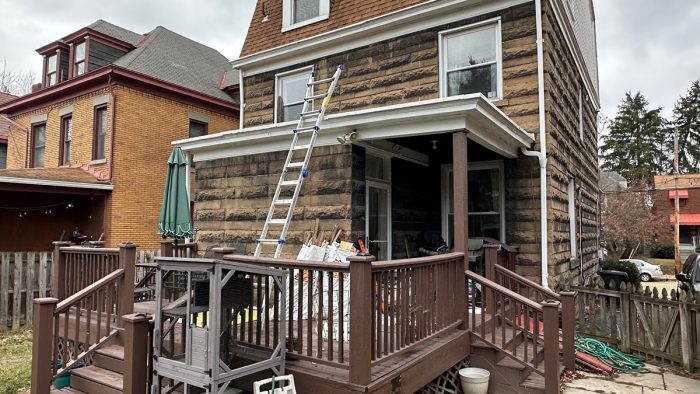
Welcome to the Fine Homebuilding podcast, our weekly discussion of building, remodeling, and design topics aimed at anybody who cares deeply about the craft and science of working on houses. This is senior editor Patrick McCombe. I’m joined by Fine Homebuilding editorial advisor Mike Guertin, producer Andres Samaniego, and new Fine Homebuilding associate editor Grant Baver. Please email us your questions to [email protected].
You can find previous podcasts and check out the show notes at finehomebuilding.com/podcast.
 |
Check in:
Mike: Rattlesnake safety
Grant: Upcoming bath remodel
Listener Feedback 1:
Evan writes:
Good afternoon,
I think I have emailed about this house before; it is a slab foundation with a screeded floor that is used as a return chase for the updraft HVAC system.
I was at the house again and snagged some photos of the exterior with my thermal camera. Before I busted out the thermal, I noticed that the paint was peeling only on the very bottom of the bricks, which I suspected had to do with that screeded floor. Sure enough, it was only peeling off the screeded-floor section, which you can see glowing on the thermal image.
Please ask the team to make some educated guesses as to what the thought process was when this house was designed. Were they trying to be cool and unique with the screeded chase? It seems like extra lumber and time to frame it out, and it’s definitely causing issues for the owner now.
Another interesting item I had not seen before was these aluminum windows that apparently have 4-in. to 6-in.-wide aluminum flanges buried behind the brick, which sounds like a mess to replace. The plan was to cut them out and replace them with some sort of flanged window. Is that good plan or should they take the brick off? There is also a cool hinged-screen detail pictured below that I hadn’t seen before.
 |
 |
 |
 |
RELATED STORIES
Listener Feedback 2:
Austin from Columbus, Ohio, writes:
Hey podcast crew!
In episode 661 you all were discussing driving nails for joist hangers, and, in that discussion, you mentioned palm nailers.
In my four-year DIY remodel, I think my favorite tool discovery was the palm nailer. I had never heard of one until I heard someone talk about them on the podcast. What a revelation! It was invaluable for joist hangers to be sure. But I also found it super practical for all sorts of nailing applications. In fact, I think for most homeowners, in most situations, I’d recommend the palm nailer over a framing nailer. It’s light. It’s easy to store. It’s just about the same speed as a nail gun. And best of all it’s inexpensive. I paid only $50 for my Bostitch—new. It’s my go-to when I need to do anything short of framing a whole house.
So, if my fellow listeners are thinking about buying a framing nailer for an upcoming project, let me suggest they consider a palm nailer instead. Just be sure to have ear protection on hand; you’re gonna need it. Big thanks to the whole FHB team for all the great insights and information that you provide to us all!
Best,
Austin
RELATED STORIES
Listener Feedback 3:
Hey FHB podcast team,
Longtime listener here. I have champagne ambitions of doing an EnerPHit to our 1898 balloon-framed house with a beer budget. 🤣🤣🤣 So I live vicariously through other people’s experiences…
Anyways, to answer your confusion on what WUFI stands for—even for Germans it’s not super straightforward, unless you’re a German engineer…
Wärme Und Feuchte Instationär
(yeah, it’s a mouthful!)
In English, that means Warmth And Moisture Transient (or Unsteady as in an unsteady state), so I suppose you could call it WAMU in English.
Thanks for your insights and knowledge on all things buildings!
Claudia
RELATED STORIES
Question 1: How do you properly insulate and air-seal behind a masonry wall in a remodel?
Ben writes:
I try to make my living as a finish/trim carpenter, but I’m also a generally agreeable person, so when a friend contracted me to turn a first floor laundry room into a combination laundry/powder room, I barely even thought about it before enthusiastically agreeing.
The house was built in 1910, and at 2-1/2 stories, it is the quintessential “steel mill manager” house located in Pittsburgh’s East End. Picture a rusticated concrete exterior, with the bottom half of the blocks still stained in soot from bygone industrial days.
My question is related to this rusticated concrete exterior and, you guessed it, properly insulating and air-sealing this assembly. At some point, a previous homeowner had dense-packed cellulose into the exterior walls. I was impressed by the job the insulation contractor had done and admired his/her work as I ripped the plaster off the wall and shoveled the cellulose into a garbage bag, never to be recycled again.
This revealed the sheathing—solid boards, nailed horizontally to the studs, with a 1/4-in. gap between boards and a lack of felt paper. This part of the house is single story (it juts out of the back of the house and leads to a deck), and it appears that two old plumbing vents are causing some roof leaks. Once these leaks are dealt with and MEP systems go in the wall, I need to re-insulate.
It is worth noting that the east and west walls are also exterior walls but do not fall within the scope of the project (my friend has a budget after all). It is the south wall that has been demolished, so the east and west walls presumably still contain dense-packed cellulose. The roof is a hip roof complete with box gutter.
For the re-insulation: Rather than dense-pack cellulose (it’s less than 250 sq. ft. and I really don’t want to have to try to source a professional machine capable of dense-packing), I’d like to try the cut-and-cobble method. Maybe I am a glutton for punishment, but being a finish carpenter, the precise cutting of the rigid foam appeals to my senses. Hell, I might even do it for free! My questions are as follows:
- What type of rigid foam should I use? What class of vapor retarder am I searching for? How much of a gap should be left around the perimeter for sealant? What type of sealant should be used? Canned spray foam or some sort of caulking? Specifically what kind of foam/caulking?
- Do I have to worry about potential spalling (or other unintended consequences) brought about by insulating this wall from the interior side? My understanding is the leakiness of the wall is what helps everything stay dry.
- Do I have to worry about thermal bridging of the studs? If so, how do I handle that?
- Should I also use batt insulation in the cavity? If so, what kind? I’m assuming unfaced?
- Is there any way I can run the plumbing supply lines in the exterior wall if certain details are tended to properly? That would be awesome from a design perspective. If this is indeed possible, what are my options for monitoring conditions in the wall (data recorders, etc.)?
Please help—I’m stuck in an obsessive loop reading FHB/Green Building Advisor/DoE / BPI articles, and my relative lack of success seems to indicate maybe this is worth addressing. This type of building construction is so common in Pittsburgh and exists in 75% of the houses I work on. I just want to understand how to think through improving this existing housing stock and not ruin my good friend’s wall.
Regards,
Ben Reese
Reese Fine Finish Carpentry
 |
 |
 |
RELATED STORIES
- GBA.com: Insulating a Concrete Block House
- GBA.com: Planning for Solar Vapor Drive
- Adding Insulation to Basement Walls
Question 2: How much insulation do you need in a sunroom?
Arnold posts on GBA about insulating his cathedral ceiling:
Hi GBA,
My current sunroom in Climate Zone 6 doesn’t have any insulation in the cathedral ceiling at the moment. The sunroom has three sides full of windows with an R-12 insulation in the 20-in. walls that those windows sit on. My wife wants to put in R-40 because she would like to keep the sunroom at 10˚C (50˚F) during the colder months, but I don’t think it’s worth the cost given all of the windows.
Without doing an energy model, what would the maximum R-value that would make sense in my situation?
Thank you,
Arnold
RELATED STORIES
- GBA.com: Five Cathedral Ceilings that Work
- GBA.com: Budget-Friendly Cathedral Ceiling
- Air-Sealed and On Piers
- Better Venter-Roof Baffles
Sign up for All-Access Membership,
Unfortunately that is all the time we have for today. Thanks to Grant, Mike, and Andres for joining me and thanks to all of you for listening. Remember to send us your questions and suggestions to [email protected] and please like, comment, or review us no matter how you’re listening–it helps other folks find our podcast.
Happy Building!
Fine Homebuilding Recommended Products
Fine Homebuilding receives a commission for items purchased through links on this site, including Amazon Associates and other affiliate advertising programs.

Affordable IR Camera

Handy Heat Gun

8067 All-Weather Flashing Tape


